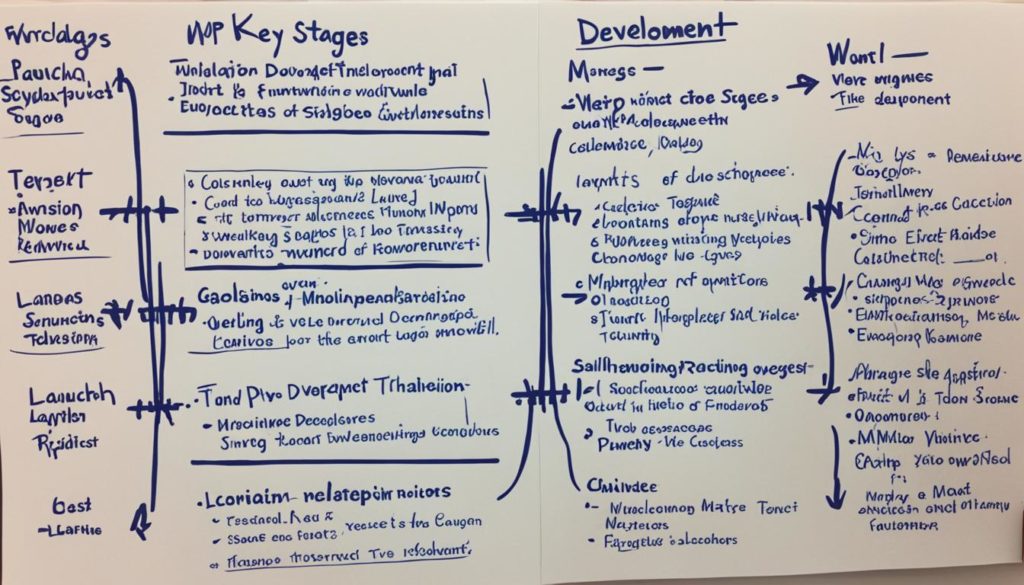
A recent survey of 30 UX pros revealed something interesting. Most find it hard not just to master UI design or user research. The real challenge is crafting a sustainable future. This huge job of improving our digital life needs more than quick fixes like wireframing. It’s about a deep commitment to making things better for users, step by step, over time.
Our journey to hit User Experience Goals is built on three key pillars: vision, goals with measures, and a solid plan. Our vision aims to create market-smart and well-researched goals. These goals set the course for UX success. We merge these aims with our broader company goals. Doing so, we ensure our strategy stands up to the real-world business test. By outlining a strategy plan with clear targets and deadlines, we turn our dreams into doable steps. This approach helps us work together across all roles, making big things happen.
Our method is more than just small changes; it’s about embedding a user-first mindset into every company goal. We do this by bringing together people, processes, and tools. This trio pushes constant innovation and makes a big impact.
Key Takeaways
- Refining the vision, goals, and strategy plan is key to achieving UX goals and improving user experience.
- UX strategies are not just about skills but setting sustainable directions for enhancing user satisfaction.
- Aligning UX measures with business objectives ensures a user-centered design that drives market success.
- A UX strategy plan must be adaptable, with a flexible time horizon to cater to the evolving user needs and market dynamics.
- The integration of DesignOps is vital for effective collaboration and coordination within UX-focused teams.
Understanding the UX Strategy Framework
A strong user experience strategy is key to improving digital platforms. It’s important for both individual product performance and the overall user experience within a company. A detailed UX strategy framework combines insights about users with business goals. This creates experiences that truly connect with users.
This approach uses user-centered design principles and business strategy. It ensures every interaction is easy for users and achieves company objectives.
Defining User Experience Strategy
A user experience strategy maps out how an organization will interact with users in the future. It plans steps to improve or change user interactions, like updating an app. This strategy links what users expect with what the business needs.
Three Pillars of UX Strategy: Vision, Goals, and Plan
Successful UX strategies rely on vision, goals, and a plan. The vision statement describes what a great user experience will look like in the future. UX goals turn this vision into real objectives. They connect users’ wishes with business goals. Finally, a clear plan lays out how to achieve these goals on time. This ensures progress can be tracked and measured.
- The vision statement states the future aim of user experience. It focuses on user needs.
- UX goals make these intentions clear and doable, linking user needs with business outcomes.
- The plan details how to reach these goals on schedule. It helps ensure actions lead to real results.
Integrating User-Centered Design in Business Strategies
Adding user-centered design into business planning changes not just products, but how a company thinks. Using UX design ideas helps make sure each business choice improves user experiences. This matches up with what users want and the market’s changes.
| Aspect | User-Centered Design Influence | Business Strategy Integration |
|---|---|---|
| Vision Crafting | Focuses on user needs and expectations | Aligns with long-term business goals and market positioning |
| Goal Setting | Targets specific user interactions and satisfaction metrics | Ensures measurable impact on business performance |
| Strategic Planning | Employs user feedback to shape the product roadmap | Fosters agility in business responses to market changes |
With these solid approaches, we build experiences that users love and that also meet business goals. A well-planned UX strategy framework helps organizations reach their goals. It also lets them keep up with user feedback and changes in the market.
The Nexus of Business Objectives and User Expectations
In the world of digital strategy, it’s key to match business objectives with user expectations. This balance is essential for hitting user experience goals. It also helps in aligning business and UX strategies. These strategies boost competitive advantage and user happiness at the same time. Our method combines trusted user research and business strategies. This mixes a user experience that fits our company mission and our users’ values.
We look into different pain points and joys from user feedback. This makes sure our product plans work and are wanted. Focusing on business objectives and user expectations leads to innovations. These are smart for business and loved by users. This process needs ongoing talks and feedback. That helps make our services better fit the changing market and user needs.
Our evidence shows a strong link between smart UX and business success. This proof comes from a study in the International Journal of Informatics Information System and Computer Engineering. It shows detailed analytics on how UX/UI affects app performance.
| Aspect | Impact on Business | Impact on User Engagement |
|---|---|---|
| Customization Features | Increased sales through personalization | Higher user satisfaction and retention |
| AI-Driven Analytics | Enhanced predictive capabilities | Improved user experience through anticipatory interfaces |
| Cyberlearning Tools | Extended market reach in educational sectors | Enhanced engagement in learning environments |
Mastering the Practice of UX Vision Crafting
In the lively world of user experience, making compelling UX visions is key. This process helps us connect with users and reach organizational goals. We aim to blend creative ideas with smart strategies. This approach leads to meaningful interactions and steady growth for businesses.
Articulating Clear and Compelling UX Visions
Creating a clear UX vision is both challenging and crucial. A well-defined vision steers product teams and stakeholders toward a common goal. By combining thorough user research with creative thinking, we create visions that resonate with users and inspire innovation.
Aligning UX Visions with Organizational Goals
It’s important to match UX strategies with organizational goals. This ensures we meet both business and user needs well. Our UX visions promote user-focused solutions that also support the company’s major aims.
Developing Differentiation through User-Centered Value Propositions
In a competitive landscape, standing out with user-centered value propositions is crucial. We use design thinking and strategic negotiation to create unique offerings. Our solutions not only meet user needs but also surpass their expectations, helping us attract and keep them.
| Element | Impact on UX | Contribution to Business |
|---|---|---|
| User Research | Provides deep insights into user needs and behaviors. | Enhances product relevance and user satisfaction. |
| Design Thinking | Facilitates innovative and effective solutions. | Drives market differentiation and growth. |
| Strategic Negotiation | Ensures stakeholder alignment and resource allocation. | Optimizes ROI and reduces development time. |
Empirical Decision Making: User Feedback Analysis and Adaptation
Improving user experience relies on analyzing user feedback. We look at qualitative and quantitative UX data. This analysis is crucial in our design process, making our UX strategies flexible.
Quantitative vs. Qualitative Data in UX Feedback
We gain insights into user behavior by studying both qualitative and quantitative UX data. Quantitative data gives us hard numbers, like how often users click through or stay on our site. On the other hand, qualitative data tells us why users behave a certain way, helping us understand their satisfaction levels.
Leveraging User Feedback for Continuous Improvement
User feedback helps us keep improving our UX projects. We make changes, big and small, to enhance how users interact with our designs. By listening to users, we make our applications better and more relevant.
Adapting UX Strategies Based on User Updates
We adjust our strategies based on what users tell us. Our approach makes sure our applications meet users’ evolving needs and preferences. This keeps our apps relevant and user-focused.
| Data Type | Tools Used | Insights Gained |
|---|---|---|
| Quantitative | Web analytics, A/B testing | User engagement statistics, bounce rates |
| Qualitative | User interviews, Usability tests | User opinions, Emotional responses |
By carefully applying both data types in our analysis, our UX strategies are well-rounded. They are informed by real user needs, making them flexible and comprehensive.
Setting and Measuring UX Goals
Delving deeper into enhancing user experience means setting and measuring UX goals is key. It involves building a clear framework that matches user needs with business goals. This approach makes sure every step we take in improving UX is backed by solid metrics showing real progress.
Establishing User Experience Metrics and KPIs
First, we need to understand and define which UX metrics and key performance indicators (KPIs) matter most. These metrics guide our UX strategy and act as our benchmarks for success. By choosing the right KPIs, we can directly link our efforts to improving user satisfaction and achieving business goals.
Tracking and Reporting on UX Progress
Measuring UX progress is about continuous monitoring and analysis. We turn data into actionable insights through constant tracking. This helps us tweak our strategies and evolve our UX design based on user needs and business changes.
Connecting UX Improvements with Business Impact
Our goal with any UX initiative is to boost business growth. We strive to ensure our efforts in UX go beyond making things look good or work well. They should also positively impact the overall performance of the business.
| UX Metric | Description | Impact |
|---|---|---|
| User Satisfaction Score | Measure of user’s satisfaction with the product or service | Directly correlates with user retention and loyalty |
| Task Completion Rate | Percentage of tasks that users complete successfully | Reflects on the efficacy and intuitiveness of the design |
| Error Rate | Frequency of errors users encounter | Indicates areas needing improvement for smoother UX |
| Conversion Rate | Percentage of visitors who take the desired action | Essential for evaluating economic effectiveness of UX |
Optimizing User Interfaces for Enhanced Engagement
We believe optimizing user interfaces for enhanced user engagement goes beyond looks. It involves understanding users deeply and applying innovative design rules. By analyzing carefully, we spot issues and plan how to make the UX interface optimization better. This changes the user experience in big ways.
We prioritize getting feedback from users across many points. This feedback is key. It helps guide our enhancements to optimize user interfaces. By aiming at user needs and likes, our interfaces are more than just working; they’re truly inviting.
Let’s explore our strategic approaches:
- Iterative design changes based on user feedback
- Adding the newest UI trends for better visual interaction
- Constant UI updates from data analysis to better user navigation
- Equipping our team to quickly adapt to UI trends and user needs
Each of these tactics is crucial for creating a strong enhanced user engagement setting. For deeper insights on these strategies, check out this detailed guide on optimizing user interfaces.
We also make sure our interfaces align with bigger business goals. This alignment helps both our users and our organizational aims. It ensures updates or redesigns are not only visually appealing but also effective and goal-driven.
| User Feedback Action | Impact on UI/UX |
|---|---|
| Enhance touchpoint interfaces | Increases user satisfaction and interaction rates |
| Streamline navigation paths | Reduces user frustration and abandonment rates |
| Integrate predictive user behaviors | Improves personalization and user engagement |
In summary, our dedication to UX interface optimization and improving interfaces is a constant process. It demands quick action, focused analysis of users, and creative design thinking. As we keep adapting and growing, our interfaces do more than function well. They bring joy and encourage users to engage more with every click.
Conclusion
As we explored the world of user experience, we learned about key elements needed to reach UX goals. It’s been clear that knowing what users need, want, and expect is essential. Using methods like surveys, interviews, and field studies helped us hear the user’s true voice. This makes sure our plans are based on real-life use and focus on users first.
We also found tools such as empathy mapping and the Why Ladder technique really valuable. They helped us understand what drives users. By creating personas and journey maps, we could see all the different user paths. This insight has sharpened our methods. It has made us committed to improving our work continually to serve users better.
Our journey shows us that the heart of our focus is a user experience that feels personal and improves engagement. As we wrap up our UX strategy work, we understand that our goals are always evolving. They guide us to a future where users and businesses succeed together.
FAQ
What are the primary goals in improving user experience?
To boost user satisfaction, we aim for seamless functionality in products and services. We meet users’ needs in ways that are easy and fun. Including user-centered design at every step is key.
Can you define user experience strategy?
It’s a plan for how a company will keep users happy over time. This strategy combines user feedback with business goals. Together, they form a roadmap focused on user satisfaction and engagement.
What are the three pillars of a successful UX strategy?
Successful UX strategy rests on three main supports. First is a clear vision for the future user experience. Second, we set goals that align with this vision. Third, there’s a concrete plan to meet these goals. We use both numbers and user comments to guide and tweak our strategy.
How can integrating user-centered design impact business strategies?
User-centered design makes sure products match what users expect. This improves how well products are received and builds user loyalty. By keeping users’ preferences front and center, companies can boost customer happiness, keep more users, and increase sales.
How does a UX vision align with organizational goals?
A UX vision supports company-wide goals by making sure the user experience helps the company grow. It can boost the brand, spark innovation, expand the market, and more. A user-focused approach makes a company’s products stand out.
What is the difference between quantitative and qualitative data in UX?
Quantitative data deals with numbers, like how often people click or make errors. Qualitative data involves understanding users’ thoughts and feelings. We gather it through interviews and watching how users interact with products.
Why is it important to establish UX metrics and KPIs?
Setting UX metrics and KPIs gives us clear goals. They let us measure how well we’re doing, see if our strategy works, and make choices based on evidence. These measures also show how UX efforts help achieve company goals.
How do we adapt our UX strategies based on user updates?
Updating UX strategies means looking at user feedback and behavior. We see what’s working and what’s not. Then, we decide whether to tweak or completely change the design. This keeps the user experience fresh and in line with tech changes.
What is involved in optimizing user interfaces for enhanced engagement?
For better engagement, we make user interfaces simple and personal. We remove things that slow users down and add features that make interactions fun. This involves a cycle of testing, getting feedback, and improving designs.
Future App Studios is an award-winning software development & outsourcing company. Our team of experts is ready to craft the solution your company needs.










